Scientific Name: Elaeagnus angustifolia
Common name:Russian olive
Plant Family: Elaeagnaceae
Article by Susan Bruneni
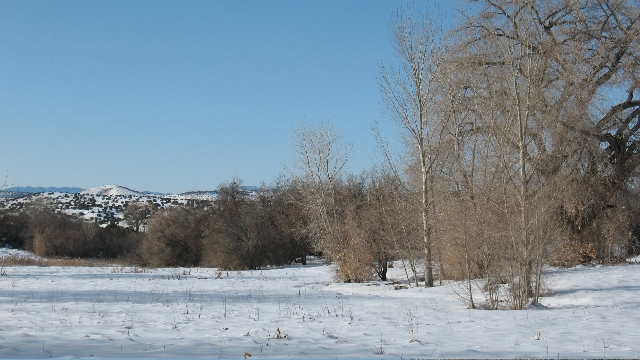
Leonora Curtin Wetland Preserve in winter (photo by Carl Troy).
On February 17, 2017, when Leonora Curtin Wetland Preserve (LCWP) is included in the Great Backyard Bird Count* (more info following this article), participants will most likely be treated to countless American robins singing while they feast on Russian olive berries, a delicacy to the robin’s palette. But this charming scene is also an example of the out-of-control spread of the Russian olive in the American Southwest.
Elaeagnus angustifolia, commonly called Russian olive or oleaster is native to Europe and Asia. It grows there as a small, usually thorny, deciduous tree or large shrub with silvery foliage, small fragrant yellow flowers, olive-like, edible fruit and is easy to maintain. It was cultivated for centuries as an ornamental tree 12-20 feet in height, or trimmed to form a hedge. Within this region it occurs primarily on coasts, in riparian areas, and in other relatively moist habitats.
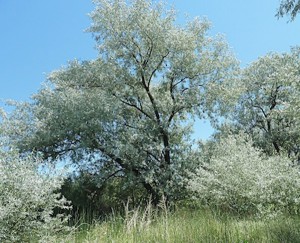
Russian olive tree (Photo by Janice Tucker)
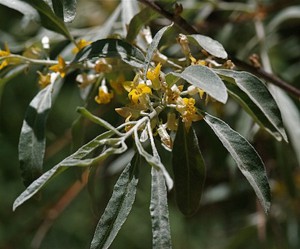
Elaeagnus angustifolia (Russian olive) by Janice Tucker
Twigs can be thorny, and the narrow leaves have a distinct silvery hue. Angustifolia means “narrow-leaf” in Latin. Fragrant flowers with four-lobed calyces appear in clusters in late spring. Flowers are small, silvery white outside and yellowish inside. They are followed in fall by an often-abundant crop of berry-like, silver-scaled fruit resembling olives in appearance. Fruit is edible, and is sometimes used for making preserves. Fruit is very attractive to wildlife.
Elaeagnus angustifolia was described by English botanist John Gerard in the mid 1500s , and was grown by John Parkinson (Royal Botanist to Charles I) by 1633. It is now widely grown across southern and central Europe as a drought-resistant ornamental plant.
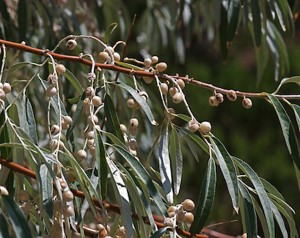
Elaeagnus angustifolia fruit by Janice Tucker
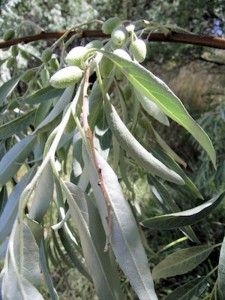
Elaeagnus angustifolia young fruit by Janice Tucker
The species was introduced into North America in the late 19th century, and was primarily applauded as an ornamental, soil erosion deterrent and wind break. It remained a cultivated plant on the East Coast and its popularity spread throughout the United States and Canada. (It will not grow in southern states where humidity is high.)
When the Russian olive was introduced into the American Southwest in the early 1900s it found its perfect habitat and “escaped” from its cultivated lifestyle, naturalizing and spreading at such an alarming rate that it is now classified as a noxious plant in 46 states. Especially in riparian areas, the Russian olive sucks up water at a much higher rate than native plants and forms a dense canopy, killing off other plant life.
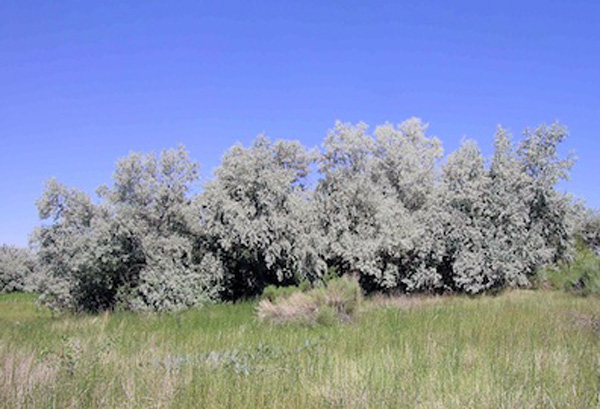
Elaeagnus angustifolia at the LCWP by Janice Tucker
When first introduced in New Mexico, batches of 50 seedlings were distributed at no cost mainly to provide quick-growing shade trees. As recently as 15 years ago the US Soil Conservation service recommended them for planting in Southern New Mexico. The plant is now a classisifcation C Noxius Weed in NM. (Class A are weeds not found in NM, B are weeds found in certain sections of NM and Class C are found throughout the state.)
According to the Bureau of Land Management, the BLM “considers plants invasive if they have been introduced into an environment where they did not evolve. As a result, they usually have no natural enemies to limit their reproduction and spread (Westbrooks, 1998). Some invasive plants can produce significant changes to vegetation, composition, structure, or ecosystem function.”
The Russian olive thrives on poor soil, has low seedling mortality rates, matures in a few years, and outcompetes wild native vegetation. Its seeds are relished by birds and small mammals and are easily spread through droppings. There are no known biological treatments or predators. It can easily destroy a native habitat and the wildlife that depends on it as a food source. Cottonwoods and willows are particularly vulnerable.
Features that contribute to its rapid spread are its resistance to varying water, soil and temperature conditions, a proliferation of seed-dispersing birds and its nitrogen-fixing ability which allows it to grow on bare mineral surfaces. Birds foraging on the Russian olive’s fruit scatter seeds at a very rapid rate, remaining viable for up to three years over a broad range of soil types.
As government, educational and commercial entities come to grips with the drastic changes associated with importing exotic plants from other environments, hopefully there will be more conscious effort to maintain the delicate balance of native plant and wild life with its unique environment.
A great benefit for Leonora Curtin Wetland Preserve is receipt of a $28,000 Youth Conservation grant for invasive species control. Three young adults will work ten hours per week during the summer months of 2017 to boost the ongoing invasive species control efforts at LCWP. Volunteers and staff have already put in countless hours to remove a number of invasive plants. Thanks to SFBG education director, Mollie Parsons for her work to receive this grant.
* February 17, 9 am Leonora Curtin Wetland Preserve Great Backyard Bird Count
See Upcoming Events to sign up >
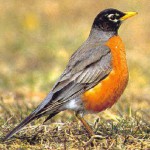
American Robin
About the Great Backyard Bird Count– Launched in 1998 by the Cornell Lab of Ornithology and National Audubon Society, the Great Backyard Bird Count was the first online citizen-science project to collect data on wild birds and to display results in near real-time. Now, more than 160,000 people of all ages and walks of life worldwide join the four-day count each February to create an annual snapshot of the distribution and abundance of birds. Leonora Curtin Wetland Preserve has participated in past years. For more information about participation at Leonora Curtin Wetland Preserve, see the Santa Fe Botanical Garden website.
References
missouribotanicalgarden.org
blm.gov
usda.gov
www.invasivespeciesinfo.gov


